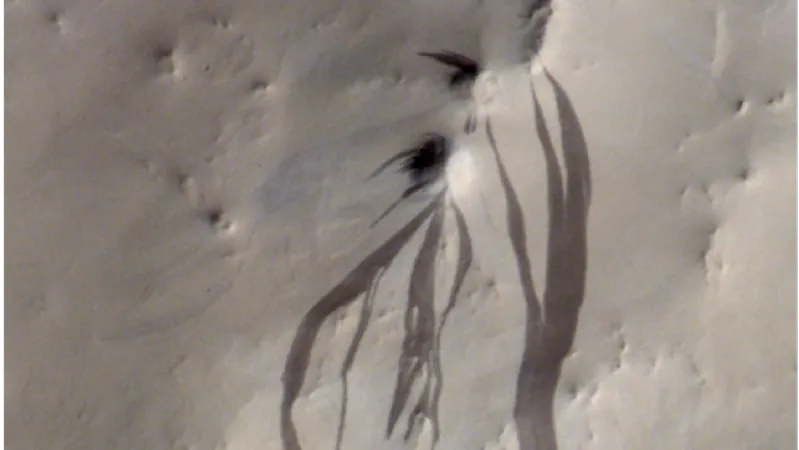
New Study Challenges Belief in Martian Water Flows: What It Means for Life on the Red Planet
2025-05-20
Author: Siti
Is Mars Really a Wet Planet?
For decades, images of dark streaks running down Martian cliffs have sparked excitement among scientists, suggesting the existence of flowing liquid water and potential conditions for life. However, a groundbreaking new study has thrown cold water on that theory.
New Findings: Dry Processes, Not Water?
Researchers analyzed approximately 500,000 images of these intriguing streaks captured by satellites and concluded that they are likely created by dry phenomena, not flowing water. This revelation reinforces the idea that Mars is a harsh, desert-like planet, currently inhospitable to life as we know it.
How Do These Streaks Form?
The study reveals that these features form when fine dust from Mars' atmosphere accumulates on slopes, which is then mobilized by winds, meteorite impacts, and even marsquakes. Adomas Valantinas, a co-leader of the study from Brown University, explained, "The tiny dust particles can create flow-like patterns without any liquid involved." Similar to dry sand, these ultra-fine particles can behave in ways that mimic the movement of water.
Where Are These Streaks Located?
Concentrated mainly in the Martian northern hemisphere, these streaks are particularly abundant in regions like the plains of Elysium Planitia, Arabia Terra, and the expansive Tharsis volcanic plateau, which includes the towering Olympus Mons—three times taller than Mount Everest.
What About Life on Mars?
Water is essential for life, and although Mars was once much warmer and wetter, the present-day planet presents a different picture. There remains a possibility that small amounts of liquid water might exist, perhaps in briny forms, sourced from buried ice or humid air. This raises the tantalizing question: Could some of these slope streaks represent habitable niches?
Limitations and Future Research
While the analysis initially focused on 87,000 images from NASA’s Mars Reconnaissance Orbiter, researchers estimate that millions of slope streaks could exist across the Martian surface. Their advanced machine-learning methods found correlations between these streaks, dust deposition, wind patterns, and geological activities—indicating that they often arise in the dustiest regions.
What’s Next for Mars Exploration?
This study’s insights are critical in the ongoing search for life beyond Earth. If slope streaks and similar features result from dry processes, it could shift the focus of future exploration toward more promising sites where water might genuinely exist.
The Implications for Habitability
As planetary geomorphologist Valentin Bickel summarized, if these features were linked to liquid water, they might hint at niches for extraterrestrial life. However, if they are merely the result of dry processes, scientists can concentrate their efforts on places with a higher likelihood of harboring life.




 Brasil (PT)
Brasil (PT)
 Canada (EN)
Canada (EN)
 Chile (ES)
Chile (ES)
 Česko (CS)
Česko (CS)
 대한민국 (KO)
대한민국 (KO)
 España (ES)
España (ES)
 France (FR)
France (FR)
 Hong Kong (EN)
Hong Kong (EN)
 Italia (IT)
Italia (IT)
 日本 (JA)
日本 (JA)
 Magyarország (HU)
Magyarország (HU)
 Norge (NO)
Norge (NO)
 Polska (PL)
Polska (PL)
 Schweiz (DE)
Schweiz (DE)
 Singapore (EN)
Singapore (EN)
 Sverige (SV)
Sverige (SV)
 Suomi (FI)
Suomi (FI)
 Türkiye (TR)
Türkiye (TR)
 الإمارات العربية المتحدة (AR)
الإمارات العربية المتحدة (AR)